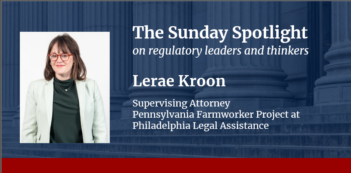
Federal labor agency proposes a new rule to end confusion over the joint-employer standard.
Some employees get a paycheck from one company but receive work instructions and discipline from another. In these cases, which business is the employer? Sometimes the answer is “both.”
The idea that an employee might have two employers, even for doing the same job, may seem counterintuitive. But potentially hundreds of thousands of companies find themselves in labor arrangements where they could be considered joint employers.
The question of how to determine whether an employee has joint employers has caused a headache for the National Labor Relations Board (NLRB) for years, and the Board has vacillated over the correct standard. In September, however, it took the unusual step of proposing to issue a prospective rule that would formally establish a joint-employer test, instead of continuing to try to work out what the test should be on a case-by-case basis when ruling on individual labor disputes.
The NLRB’s proposed rule would limit joint-employer status to businesses that exercise direct and immediate control over working conditions, rather than including businesses that have indirect and reserved powers over workers. The Board acknowledges that under its proposed standard, fewer businesses would be recognized as joint employers.
How such a rule would play out in subsequent cases before the NLRB could impact many kinds of workers. In its proposed rule, the NLRB cites a number of employment situations where joint-employer challenges likely arise, including temp agencies, franchises, and businesses that enter contracts with other companies to provide services.
For employees at these companies, a new joint-employer standard could significantly restrict their ability to unionize. If the NLRB recognizes two businesses as joint employers, workers who have organized a union can force both businesses to come to the bargaining table and enter into negotiations for a union contract.
For instance, if workers organize at a franchised fast food restaurant, like many McDonald’s or Domino’s Pizza restaurants, a union that can bargain only with the owner of the local franchised location—and not the bigger company—would be of limited use. The bigger company that sold the franchise rights to the local franchisee often dictates many policies that workers might want to change. The larger company also can set prices that the local franchisee can charge its customers, which can constrain the franchisee’s ability to raise its workers’ wages.
If the larger company—say, McDonald’s or Domino’s Pizza—is not found to be a joint employer, it will not have to sit down and be part of labor negotiations with the local franchisee and the union. Workers will then have fewer terms they can negotiate for in their union contract, and it might even be illegal under the National Labor Relations Act (NLRA) for them to take actions to influence the bigger and more powerful company that sells the franchise.
The Board’s proposed rule would depart from current law, which requires a union to only show that a business has “indirect, limited, and routine” control over working conditions to be considered an employer—which could include those bigger companies that sell franchises. It even includes businesses that have control over employees that is “contractually reserved but never exercised.” Under this current standard, businesses that have the power to fire workers but have never used that contractual right could still be considered a joint employer of those workers.
By contrast, the proposed rule would require a business to exercise “substantial direct and immediate control over the employees’ essential terms and conditions of employment in a manner that is not limited and routine” for it to be deemed a joint employer. This standard, unlike the existing one, would require extensive involvement in working conditions before a company could be considered a joint employer.
The NLRB’s proposed rule comes on the heels of other attempts to change the joint-employer test since President Donald J. Trump took office.
The Board’s members originally opted to change the existing standard to a more restrictive one when it decided a case in 2017. After the NLRB issued its decision in that case, however, it came to light that one of the Board members should have recused himself because his former law firm had been involved in litigating the decision that the Board was overturning. As a result, the Board’s decision was vacated and the standard reverted to the broader definition that is currently the law. This broad standard is also, however, facing a challenge in federal court in some ongoing litigation.
Into this mix, the current NLRB has introduced its proposed rule to restrict the joint-employer test via the adoption of a regulation—a highly unusual move for the Board to make. The Board usually establishes its standards in the context of deciding specific cases involving labor disputes; it has not traditionally used rulemaking.
Prior to the Obama Administration, the NLRB had only issued one substantive rule—one that governed the size of bargaining units in health care facilities. Even during the Obama Administration, the NLRB issued only two rules. Setting standards by rules has its consequences, for it makes labor standards harder to change than when the Board sets policy in case-by-case decisions.
In support of its proposal to adopt a restrictive rule, the majority of the Board states that the current indirect control test—which had been adopted during the Obama Administration—itself departed from a standard that had traditionally applied. The Board members currently in the majority—now all Republican appointees—view the Obama Administration’s holding as an ill-advised departure from earlier precedent. These majority members also argue that rulemaking is now necessary because workers and businesses need predictability in their labor relations.
Yet Board Member Lauren McFerran, a Democratic appointee, disagrees with the Board’s argument for rulemaking. Offering her dissenting views in the Federal Register announcement of the Board’s proposal, McFerran argues that rulemaking is ill-suited to addressing the joint-employer issue because cases will require extremely case-specific analysis of the facts and no regulation can appropriately capture all the nuance. This shortcoming means adjudication will still be necessary to flesh out the parameters of the new rule.
McFerran also argues that the Board’s proposed rule breaks from the common law and discourages collective bargaining, which the NLRA promotes. She argues that revoking the broader standard will only add to confusion, rather than alleviate it as the majority hopes, partly because a federal court is still reviewing the current broad standard.
Regardless of which standard prevails, the proposed joint-employer rule may indicate a significant change for the NLRB. For an agency that has typically refrained from substantive rulemaking, perhaps this proposed rule could mark a turning point for how the Board will make other policy decisions in the future.
The public has until December 13, 2018 to submit comments on the proposed joint-employer rule.



